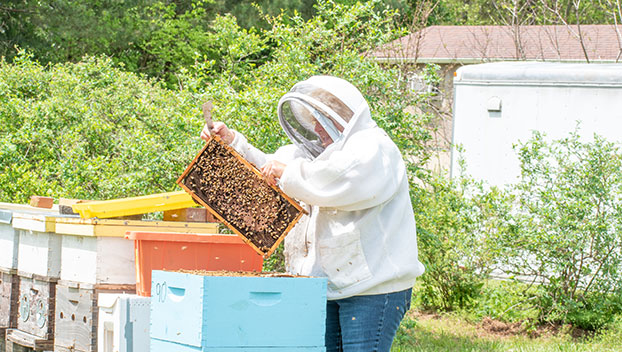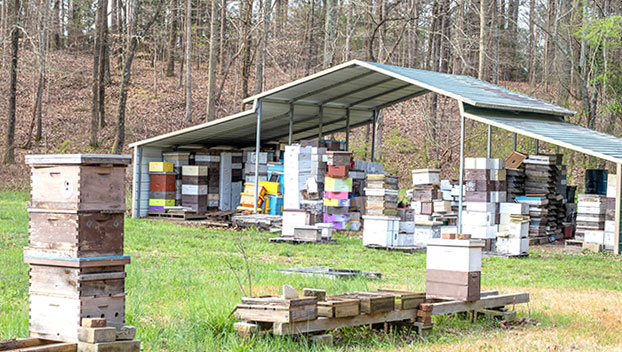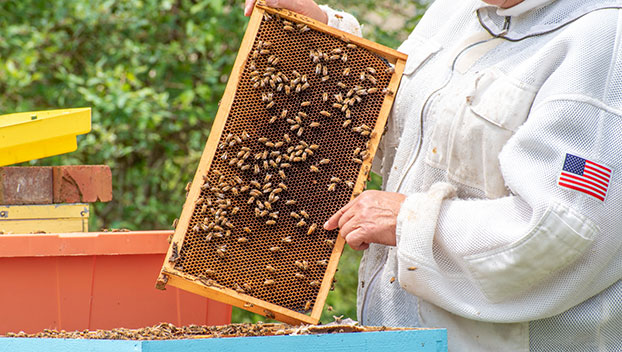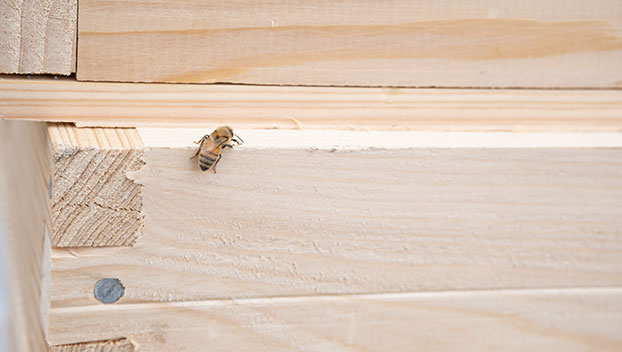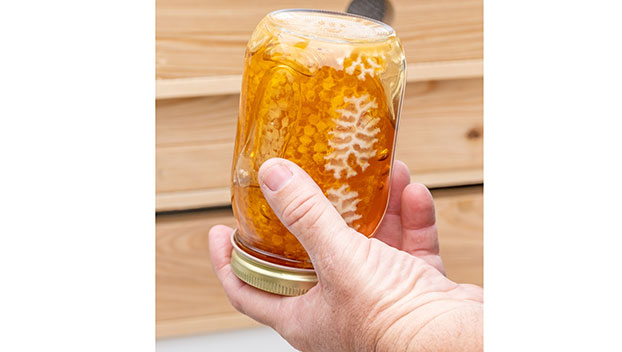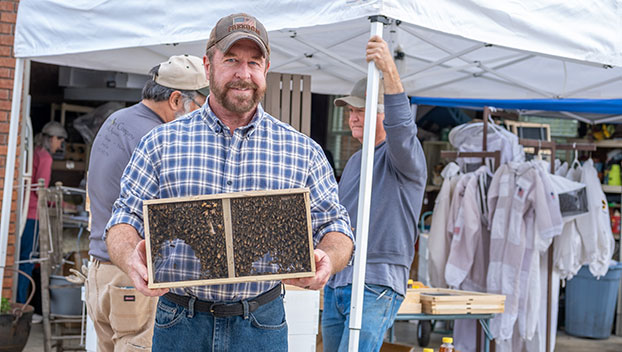Beekeeping is buzzy business
FRANKLIN LIVING MAY-JUNE 2023
For the past 13 years there’s been a lot of bees busily buzzing about at T and A Bee Farm. Located between Belgreen and Red Bay, the farm was started in 2010 by Angie and Ted LeMay.
To get ready for their beekeeping venture, the couple spent one winter reading up on beekeeping, poring over books and researching online, before diving in. They also attended classes and conferences, including the Alabama Beekeepers Conference, as well as networked with other beekeepers.
“There are a lot of classes available around the state and a lot of local bee clubs always willing to mentor those interested as well as offer education at their meetings,” explained Angie Lemay, noting the closest group is in Tuscumbia.
CLOSE COMMUNITY
Lemay said she has become friends with some of her customers, and fellow beekeepers who have become friends often help out at T and A Bee Farm. She said the beekeeping community is great to help each other out. It’s one of the things she enjoys most about being a beekeeper.
“We got three hives our first year, and the operation has grown tremendously since then,” she said, noting the farm now has about a hundred hives with an estimated 8-10,000 bees in each one – a number likely to triple by June, after the queen bees have laid their eggs and the new bees have hatched. Hives at T and A Bee Farm are composed of stacked wooden boxes, 19 by 21 or 24 inches and about 10 inches tall. While “hobbyist beekeepers” — those with 40 hives or fewer – are plentiful across the nation, Lemay’s operation falls between “sideliner” and “commercial” status.
“Ted had wanted bees ever since he was a little boy,” Lemay said. She said although she was initially not excited about the prospect of entering the world of beekeeping, that soon changed. “About three weeks in, I was out there right beside Ted, wanting to work with him.” Ted passed away in October 2021, after 15 years of marriage to Angie, about 11 of them in the bee business together.
Greg Whitten, of Florence, is among the hobbyist beekeepers. He’s been at it for five years and usually keeps about three hives. He said when the hives are strong, there’s usually 30-50,000 in each one. He doesn’t sell his honey. Instead, he keeps it for personal use and gifts.
“There’s a steep learning curve, but beekeeping is very enjoyable,” Whitten said. “It’s really fun. It’s amazing to see the nature of the bee relationships within the hive and how everything works.”
Stacy and James Sneed have been beekeeping for about four years.
“We got our bees from Ted and Angie,” Stacy said. “We started with three hives, and now we have seven. We started because our garden wasn’t doing very well, and we needed pollinators.”
They explained got the idea for beekeeping while visiting her mother in Georgia. They went to a workshop about beekeeping and “immediately felt drawn to it.” They now help out at T and A Bee Farm, in addition to taking care of their own bees.
James said while beekeeping can be stressful, “especially when first starting out – scary some days,” it can also be fun. “Trying to keep the bees alive is the main concern,” he explained. “We lost several hives this year due to hive beetles, and they were a big problem last year, too.”
Quinn and Danette Karnes also bought their bees from T and A Bee Farm. They’ve been at it five years and have 13 hives. Quinn said one interesting approach is for the bees to make honey directly in jars. “The bees actually build the combs inside the jars and fill them with honey,” he explained.
QUEEN BEE
“Bees are amazing creatures. The hive acts basically as one entity,” Quinn noted. “All the queen does is lay eggs, and the worker bees do everything else.”
While a queen might stay productive for three or four years, some beekeepers change theirs out more frequently to help ensure the hive strength – a practice LeMay follows, replacing the queen once a year.
The popular notion of “the queen bee” being the big boss is not quite reality when it comes to literal bees. The queen bee’s activities include making a pheromone the other bees can smell; mating; and laying eggs. She doesn’t make decisions about the hive. If there get to be too many bees in a hive, they can no longer smell the queen, and if she gets injured or isn’t laying enough eggs, they will quit feeding her.
When that happens, she loses too much weight and can’t fly, and the other bees kick her out. The oldest bees in the hive, approximately a third of them, will follow her to find a new place to establish a hive. Scout bees locate a place for a new hive.
GATHERING HONEY
Keeping bees means keeping busy. Much must be done to try to ensure the health of the hives and the quality of the honey. The bees are in frames in boxes, and they cap their honeycombs over with wax. The “honey house” is where the honey extracting takes place on the farm.
“I have to take a hot knife to remove the wax capping,” explained LeMay, “and then I stand the frames down in an extractor, and it spins, which causes the honey to sling out.”
It’s necessary to be careful when working with bees, especially while engaged in certain tasks. Despite taking precautions, Lemay said she still gets stung “pretty much every day I work with them,” sometimes as many as 15–20 times in one day. LeMay brushes this off, explaining it just comes with the territory of beekeeping. She also has a trick for treatment – applying mint toothpaste to the stings helps take the edge off.
LeMay said a device called a fume board helps subdue the bees. “You put it on top of the hive whenever you go to pull the honey off, and the almond-cherry scent causes the bees to go down into a lower box, but they’re still active; they just don’t like the scent,” she explained. “I’ve had hives that were 10 or 11 boxes tall, so it just keeps driving them to go to lower boxes.”
This process is called “pulling honey,” and LeMay said it’s important to wear protective gear – a special jacket and mask that connect firmly – in addition to using the fume board. “As you take a box off, some of the bees will fly out, so they’re going to be around you,” she said.
As bees go, she said hers are a “very calm” breed – Italians, the most common type kept in the United States. She doesn’t generally wear her protective gear around them “until it’s about honey season.” While some beekeepers use gloves, Lemay doesn’t, finding she has better use of her hands without them.
“In the springtime, the bees are just much more docile,” LeMay explained. “They’ve got their brood and their eggs to protect, but it’s generally when they have the honey in there that I get stung.”
She said a sting can sometimes happen from accidentally mashing a bee when picking up the frames. “Once they’ve stung you, they give off a pheromone that smells like banana taffy,” LeMay added. “It indicates the bees are getting irritable, and you better have your protective gear on. If I’ve got my smoker going, I’ll smoke the area to get rid of the scent.”
BEE BUSINESS
LeMay’s business isn’t just selling honey. She also sells packaged bees, “nucs” – nuclei – equipment and accessories, in addition to conducting classes for those interested in taking up beekeeping. She also creates bee-themed embroidery products to sell, along with soaps, lotions and lip balms made from the wax and honey. In addition, LeMay is a distributor for three companies selling “anything you would need for beekeeping, from protective gear to medications, boxes and more.”
She said many of her customers have reported they find consuming the local honey helpful against allergies, as it contains pollens from the area.
“My honey is raw and pure. The only thing I do is strain it,” she explained. “If you filter, you are taking out a lot of the pollens, and that’s what helps people with their allergies.”
LeMay also touts honey’s other many benefits, including helping keep moisture in the skin, the reason it’s sometimes included in lotions and creams. She also finds it helpful for burns and cuts. “If I have a burn, I put honey on it, and from my own experience, I feel like it works better than Aloe Vera.”
“Never heat honey about 110 or 115 degrees Fahrenheit because it’ll kill off a lot of the good things in it,” she added.
PESTS
There are a few pests that threaten bees, including the hive beetle, wax moth and varro mite.
“If you’ve got a good, strong hive, your bees will keep those hive beetles run up to the top. If the hive is not strong, those hive beetles get down in there, and they can actually cause a hive to leave,” LeMay explained. “They do this hoping to lay their eggs in the empty comb.”
She said the varro mite to a bee is somewhat akin to a tick to a human. “They weaken the immunity of the bees, and they carry viruses.
“I only use natural treatments to deter the pests,” LeMay added. “Any pesticides you put on a hive will be damaging to the bees or even have a carryover into the comb and honey.”
Another peril for bees is what’s known as Colony Collapse Disorder, and LeMay said experts aren’t sure what causes it, but it can happen any time of the year. “It’s a big problem, probably second to the mites,” she said.
At her home, most of her bees are in hives in a special area known as an apiary – honeybee yard – though she has a few bees closer to her house. USDA inspectors come and inspect her setup. Hives have to be registered. Inspectors watch for things like viruses and provide advice when needed.
WORK THAT’S WORTH IT
The United States Department of Agriculture website explains there are more than 100 crops grown in the U.S. that depend on pollination from honey bees and other insects. LeMay said bees love squash, cucumbers, pumpkins, melons and “a lot of different things,” – it’s not just about flowers and bushes.
LeMay said though beekeeping is a lot of work, it’s also very rewarding.
“This is my full-time job. It can be challenging, but it’s also a lot of fun and interesting to work on the different aspects,” she said. “I’m getting ready for the next honey season now, and both and I the bees have plenty to keep us busy.”


